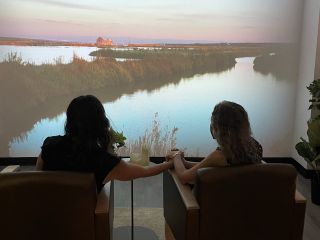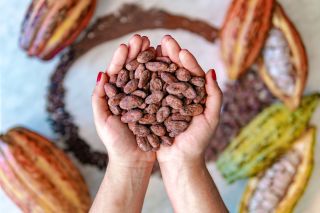Relationships
Love and Chocolate: Two Ways to Calm and Energize
Hold your loved one’s hand and eat chocolate to reduce stress and boost energy.
Posted February 8, 2024 Reviewed by Ray Parker
Key points
- Studies show holding hands with a loved one lowers the stress response and enhances well-being.
- People with many positive, social relationships have fewer viral infections.
- Chocolate activates dopamine-reward-brain regions and increases brain processing speed and alertness.

From the moment we are born, we crave the love and affection of others. It is the stuff of which all great stories are made. In this area, science tells us what we all know: Stable, healthy interpersonal relationships enhance our overall well-being. In contrast, negative relationships are significant sources of stress and can impair our physical health.
The late John Cacioppo, professor of psychophysiology and social psychology at the University of Chicago, showed decades ago that holding hands with a loved one can instantaneously lower blood pressure, reduce heart rate, and increase heart rate variability—all signs of reduced stress and increased relaxation responses—while holding hands with a stranger did the opposite. Indeed, a recent study showed that heart rate variability increased in couples who held each other's hands after an argument, and both partners' moods improved, suggesting that touch is an important way to reduce stress in loving couples.
Touch activates the vagus nerve and the relaxation response even in newborn infants. In the 1990s, psychologist Tiffany Field found that massaging her premature infant reduced her baby's stress behaviors. She went on to develop a method of massage in premature infants that helped infants thrive. They gained weight, and their digestion improved, all through the effects of touch on the activation of the vagus nerve.
Sheldon Cohen, a psychology professor at Carnegie Mellon University whose team showed that stressed persons are more susceptible to common cold infections, also showed that the more positive, loving relationships we have, the less likely we are to get sick from viral illnesses. Conversely, isolation increases the stress response and the number and severity of viral infections, like the flu or the common cold.
Imagine that you are stuck in a hospital room for eight weeks in a row, and none of your loved ones can visit you there—as happened to many during the height of COVID. What if all you could see out your window was a view of a brick wall or, worse still, a lot of pipes and HVAC equipment? In 2010, Professor Shaun McCann, a hematologist in Dublin, Ireland, studied a group of bone marrow transplant patients who were routinely isolated in such rooms for up to eight weeks at a time and forbidden from going out or receiving visitors, so high was their risk of infection.
To alleviate their isolation, McCann set up liquid crystal display (LCD) projectors on the ceilings of the patients' rooms and asked the patients what images they wanted to see. One response was universal: images of their loved ones. One man loved to stand on his balcony with his partner and watch the construction across the street. So, McCann set up a webcam on that patient's home balcony and projected the video onto the hospital room wall so he could watch with his partner from afar.
It turned out that the patients who had access to the projected images, including those of loved ones, had less anxiety, less depression, and a significantly better quality of life—both during and after their eight-week confinement—compared to those who didn't have such access. In the years before, we could immediately conjure up our loved ones via smartphones and videoconferencing no matter where they were; this technology gave these isolated patients a connection to friends, family, and the outside world.

In a high-tech version of McCann's approach, video game creator Mirelle Phillips left the videogame industry after recovering from neurotrauma and turned her skills to helping people in hospitals access nature. She created an immersive reality nature, "recharge rooms," just before COVID hit. During COVID, these rooms proved to be a lifeline for healthcare workers seeking a place of respite and calm. Phillips and her colleagues are finding that these immersive reality nature experiences not only reduce anxiety, stress, and burnout but bring people experiencing trauma together to support one another.
So, being with loved ones, even virtually and at a distance, improves one's health and mood.
What does all this have to do with chocolate? It turns out that chocolate turns on some of the same brain-positive mood regions that loving relationships do: dopamine reward and feel-good anti-pain endorphin pathways. Chocolate even contains anandamide, the brain's natural cannabinoid that brings on euphoria. The use of chocolate as both a stimulant and medication for numerous illnesses goes back thousands of years.
There is evidence that hot drinks derived from the cacao bean were drunk in Mesoamerica as early as 2,000 to 1,000 BCE. Chocolate comes from the beans of the Theobroma cacao plant, named by Swedish botanist Carl von Linné, or Linnaeus, in 1753, who combined the Latin word Theobroma—literally "food of the gods"—with a derivation of the Aztec word for bitter water—xocoatl.
In fact, the Aztecs believed that the god Quetzalcóatl brought the cocoa tree with him to earth on the rays of light from the star of the morning—a fitting tribute to the way it makes us feel awake and alert. The Mayan people, whose Mesoamerican ancestors had used cacao for thousands of years for its energizing powers, made a hot drink from the ground beans mixed with cinnamon and pepper. It is still flavored that way in Mexico and Central and South America, as the pepper gives a gentle kick to its sweet taste.

Two decades after Christopher Columbus first came upon cacao, supposedly when he accidentally captured a canoe full of odd-looking beans, the Spanish conquistador Hérnan Cortés encountered the delicious brew at Montezuma's court and promptly brought it back to the king of Spain. In his report to the king, Cortés touted its powers to fight fatigue and as an aphrodisiac, writing that Montezuma drank a special cacao concoction before conjugal visits with his wives. Today, this effect is debated because the chemicals in chocolate that bind to cannabinoid receptors, producing euphoria, are in such low concentrations in chocolate and so quickly metabolized. It is thought that most of the effects of chocolate on sexual desire are not related to its chemistry but rather to its other sensory effects: its fragrance, color, and taste. Even the rich, creamy texture of melting chocolate and its feel in your mouth is sensual.
There is no question that chocolate's chemical constituents are energizing and can make one's heart flutter and make one feel flushed and even anxious, in many ways mimicking the physiology of sexual arousal and feelings of being in love. When consumed in moderate quantities, dark chocolate (as long as it is not contaminated with heavy metals)—has many health benefits in addition to being energizing, including reducing inflammation and lowering blood pressure.
Its many chemicals that confer these properties include minerals, like iron, zinc, copper, and magnesium, and a high content of flavonoids and other polyphenols–anti-inflammatory antioxidants that lower blood pressure and reduce insulin resistance. Their vascular effects increase brain blood flow and improve the brain's processing speed, executive functions, and memory. They benefit nerve cell growth and survival, suggesting chocolate may help prevent cognitive decline and stave off dementia.
Of course, familiar to us all are cacao's other ingredients, theobromine and caffeine, which keep us alert. So, if you bite into a square of dark chocolate during a lull in the afternoon, you can feel good about its health benefits.
There's one more benefit linking chocolate to loving relationships. Chocolate has long been considered an ideal gift affirming one's love. Giving, in itself, improves the health and well-being of the giver. Altruistic love and generous actions reduce stress, enhance the relaxation response, improve mood, protect against depression, and trigger those feel-good dopamine rewards and anti-pain endorphin brain regions.
The combination, too, can help boost your immune system's ability to fight disease. So, go ahead and hold your loved one's hand, give them a gift of chocolate, and eat some together to feel both calm and energized at the same time.
Portions of this post were excerpted and condensed from my book, Well at Work: Creating Wellbeing in Any Workspace. New York, NY: Little, Brown Spark.
References
Portions of this post were excerpted and condensed from: Sternberg, E.M. (2023) Well at Work: Creating Wellbeing in Any Workspace. New York, NY: Little, Brown Spark.
Afoakwa, E. O. Cocoa and Chocolate Consumption – Are There Aphrodisiac and Other Benefits for Human Health? S. Afr. J. Clin. Nutr. 2008, 21, 107–113.
Berntson, G. G., & Cacioppo, J. T. (2004). Heart rate variability: Stress and psychiatric conditions. Dynamic electrocardiography, 57-64.
Besa, R., Angelo, E., Cutroneo, A., Frieman, A., Paliwal, M., & Williams, D. (2023). Effect of Nature-Themed Recharge Room on Healthcare Workers' Level of Stress and Anxiety. JONA: The Journal of Nursing Administration, 53(9), 481-489.
Bruinsma, K., & Taren, D. L. (1999). Chocolate: food or drug?. Journal of the American Dietetic Association, 99(10), 1249-1256.
Cacioppo, J. T., & Patrick, W. (2008). Loneliness: Human nature and the need for social connection. WW Norton & Company.
Cohen, S., Tyrrell, D. A., & Smith, A. P. (1991). Psychological stress and susceptibility to the common cold. New England journal of medicine, 325(9), 606-612.
Cohen, S., Doyle, W. J., Skoner, D. P., Rabin, B. S., & Gwaltney, J. M. (1997). Social ties and susceptibility to the common cold. Jama, 277(24), 1940-1944.
Cohen, S. (2021). Psychosocial vulnerabilities to upper respiratory infectious illness: implications for susceptibility to coronavirus disease 2019 (COVID-19). Perspectives on Psychological Science, 16(1), 161-174.
Conradi, H. J., Noordhof, A., & Arntz, A. (2020). Improvement of conflict handling: hand-holding during and after conflict discussions affects heart rate, mood, and observed communication behavior in romantic partners. Journal of Sex & Marital Therapy, 46(5), 419-434.
Dillinger, T. L.; Barriga, P.; Escárcega, S.; Jimenez, M.; Salazar Lowe, D.; Grivetti, L. E. Food of the Gods: Cure for Humanity? A Cultural History of the Medicinal and Ritual Use of Chocolate. J. Nutr. 2000, 130, 2057S–2072S
Field, T. (2016). Massage therapy research review. Complementary therapies in clinical practice, 24, 19-31.
Lippi, D. (2015). Sin and pleasure: the history of chocolate in medicine. Journal of agricultural and food chemistry, 63(45), 9936-9941.
Miller, L., Wickramaratne, P., Hao, X., McClintock, C. H., Pan, L., Svob, C., & Weissman, M. M. (2021). Altruism and “love of neighbor” offer neuroanatomical protection against depression. Psychiatry Research: Neuroimaging, 315, 111326.
Post, S. G. (2014). Altruism, happiness, and health: It's good to be good. An Exploration of the Health Benefits of Factors That Help Us to Thrive, 66-76.
Putrino, D., Ripp, J., Herrera, J. E., Cortes, M., Kellner, C., Rizk, D., & Dams-O’Connor, K. (2020). Multisensory, nature-inspired recharge rooms yield short-term reductions in perceived stress among frontline healthcare workers. Frontiers in Psychology, 11, 560833.
Sternberg, E.M. (2009) Healing Spaces: The Science of Place and Well-being. Cambridge, MA: Harvard University Press.
Sternberg, E. M. (2011). Approaches to defining mechanisms by which altruistic love affects health. Stony Brook, NY: The Institute for Research on Unlimited Love. Retrieved April, 15, 2011.
Tunick, M. H., & Nasser, J. A. (2019). The chemistry of chocolate and pleasure. In Sex, smoke, and spirits: The role of chemistry (pp. 33-41). American Chemical Society.
Wilson, P. K., & Hurst, W. J. (2012). Chocolate as medicine: A quest over the centuries. Royal Society of Chemistry.




